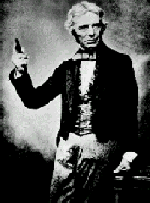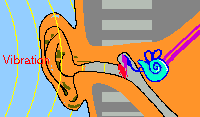



© Brian Cross & UK DETECTOR NET 2025

How a Detector Works
This page designed and created by Andy G of Water Web
A lot of you have been writing to Brian & Mo' asking how a Metal Detector actually works. They in turn have passed your letters onto me.
To save time I have created this page to try and assist you in your quest for knowledge. I hope you find it useful.........................Andy
The metal detector is essentially a coil of wire with a current flowing through it, the coil acts like a magnet and as the magnetic field passes over a piece of concealed metal the properties of the coil change. This change results in an equal change to the current flowing in the coil and this change can be measured. Hey presto a metal detector.
To understand fully how this device works we need to understand some basic physics (sorry, but it is a sad fact of life..) Namely :-
* The electro magnet
* Induction
* Oscillation
So grab a cup of tea (or whatever national drink you prefer) and lets get going.
The electro magnet
An electromagnet is a coil of wire, usually wound around an iron core, that produces magnetism as long as an electric current flows through the coil. Electromagnets act like permanent MAGNETS but as we shall the the strength of the magnetic field can be easily varied.
An electromagnet's magnetism, however, unlike a permanent magnet's, can be turned on and off, making it useful in operating electrical devices with movable magnetic parts, such as generators, motors, brakes, clutches, relays, and other devices such as Metal detectors.
The strength of the magnetic field depends on several things,
1. The number of turns on the coil
2. The size of wire used to wind the coil
3. The Voltage source applied to the coil
As the electric current flows through the coil a magnetic field is produced around this coil hence the term Electro Magnet.
That’s all we actually need to know about Electro Magnets but if you want more information let me know and I'll respond as best I can.
Induction
Electromagnetic induction is the creation of an electric field by a fluctuating magnetic field. The electric field may be produced, according to Faraday's law of induction in two ways: by the motion of a conductor cutting across the lines of magnetic flux of a magnetic field or by a change in the magnetic flux passing through a coil immersed in a non constant magnetic field.
Michael FARADAY observed (1831) that when a magnet is moved through a closed coil of wire, a current is induced in the wire. The direction of the current flow is such as to create a magnetic field opposite in direction to that of the change in the field produced by the magnet. Faraday then replaced the magnet with an electromagnet.
Two coils were wound close together, the first being connected to a battery and the second to a galvanometer, which measures small currents.

Picture of Michael faraday
Faraday noticed deflections of the galvanometer needle when the connection between the first coil and the battery was made or broken. The currents induced at those two moments flowed in opposite directions. No current flowed in the second coil when a large, steady current flowed in the first. The significant feature of the previous experiment, therefore, was the change in the magnetic field. What Faraday had done was to build the first TRANSFORMER. The changing current in the first coil (the primary winding) set up a time-varying magnetic field that penetrated the second coil (the secondary winding) and set up an electromotive force in that coil, causing a current to flow there. Transformers were not put into practical use until the introduction of ALTERNATING CURRENTS. That's the scientific explanation
From our point of view
The most important application is that of the metal detector. We know that the coil produces a magnetic field. We know that a magnetic field is made up of lines of magnetic flux. If these line of flux CUT any metal object (a conductor), then a current is INDUCED in that piece of metal.
If you can accept all this then we are doing well. There is now only one small piece missing in the jigsaw. The piece of metal itself when detected will have a small current flowing inside it DUE TO INDUCTION. The piece of metal will therefore act as an electro magnet This new magnet will oppose the magnetic field of the detector causing more current to flow in the detector's coil. In other words, altering the inductance of the coil. We can measure this alteration on an Ammeter or by altering an audile tone.. Easy isn't it
Oscillation
Everything oscillates. Oscillation basically means vibrating. If an object vibrates at a certain rate then it becomes audible to the human. The scientific name for this vibration is frequency.
Within the field of science we can build an electronic oscillator. This is based on induction and capacitance. (I wouldn't like to discuss capacitance in the scope of this page, but if you want more info, get in touch).
So the coil in your detector acts as part of an oscillator. (The knob you twiddle alters the capacitance which alters the frequency so you can hear it). As the detector passes over a piece of metal then the inductance alters and the frequency alters and you do the rest..

Ear picture
Summary
O.K. That s basically how a metal detector works, I hope it's been of use. To summarise, the metal detector is made up of various parts. The electro magnet, the oscillator and the capability to vary the inductance of the coil.
The magnetic field passes over a piece of metal, the detected metal has a current induced in it which sets up its own magnetic field. This alters the inductance of the coil and thus results in a change of frequency in the metal detectors' oscillator.
Copyright. Andy G